Just Another Weekend in Williamsburg: Eight Impressions from BEMF 2014
Now in its seventh year, the Brooklyn Electronic Music Festival (a.k.a. BEMF) could still be […]
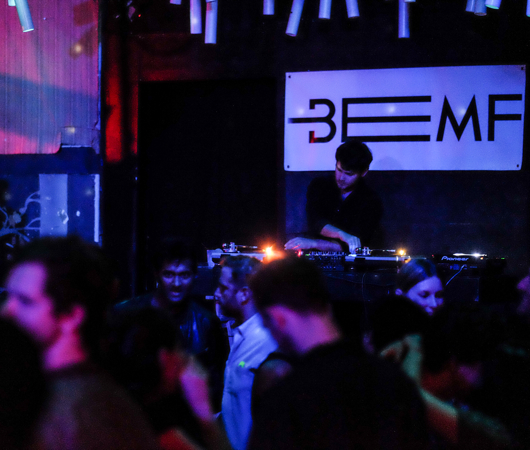
Just Another Weekend in Williamsburg: Eight Impressions from BEMF 2014
Now in its seventh year, the Brooklyn Electronic Music Festival (a.k.a. BEMF) could still be […]

Now in its seventh year, the Brooklyn Electronic Music Festival (a.k.a. BEMF) could still be considered somewhat of an adolescent by festival standards. While this year’s edition boasted the strongest line-up yet, it also seemed to suffer from an identity crisis. In a borough with so many entertainment options and subcultures, it can be difficult to create a festival that pleases every single electronic music fan. (We were hard pressed to imagine someone who would jump at the chance to take in both Galantis‘ arena-ready EDM and Alessandro Cortini‘s creepy ambient explorations, for example.) And yet, like last year, BEMF continued to want to be all things to all people. Despite its perhaps overly ambitious aims, we still had an enjoyable time at the 2014 edition of the festival; there were more than enough artists to get excited about, and a few unexpected highlights along the way, which we’ve compiled into a list of the eight lasting impressions from the eventful BEMF weekend.
The Black Madonna
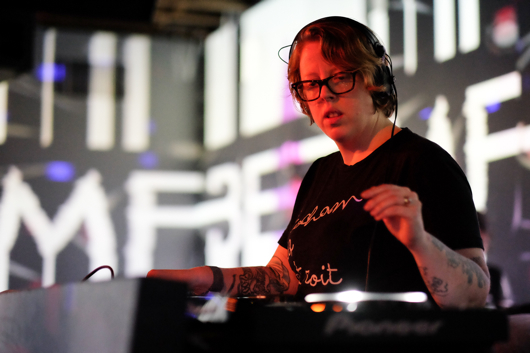
Machinedrum
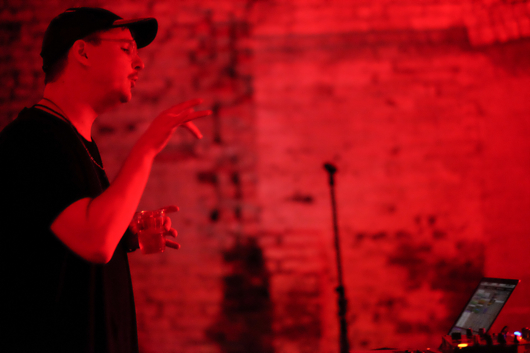
BEMF still doesn’t really feel like a festival.
Apart from a few painted stencils around Williamsburg and a large video projection which temporarily plastered the BEMF logo on the side of a brick building, the festival atmosphere in Brooklyn’s hip enclave was decidedly lacking. Perhaps the chilly weather had something to do with it—the streets seemed dead on Friday night, more desolate than even a typical weekend in the neighborhood. Attendance seemed to be a mixed bag as well. Some events, like DJ Shadow and Cut Chemist‘s tribute to Afrika Bambaataa, were stuffed with so many people that it partially detracted from the experience, while other events were sparsely attended.
This gave us the impression that more people were buying tickets to individual shows, rather than spending $100 necessary to purchase a full festival pass. And with tickets for most events in the $20 to $25 range, for many people it probably made more sense to just pick one or two favorites from the entire schedule. Perhaps BEMF is still a tough value proposition because it caters to underground electronic fans, EDM ravers, and New York club lifers all at the same time. There was a little something for everyone, but in the end, maybe not enough to justify getting a two-day pass.
DJ Shadow and Cut Chemist
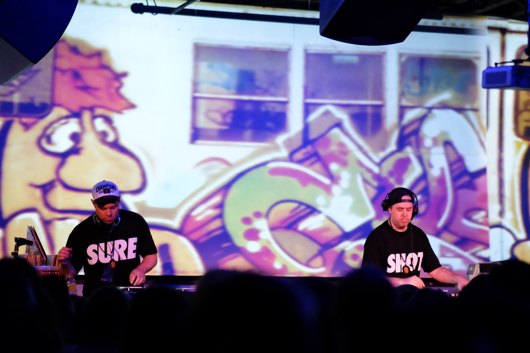
Visuals inside Brooklyn’s Villain club
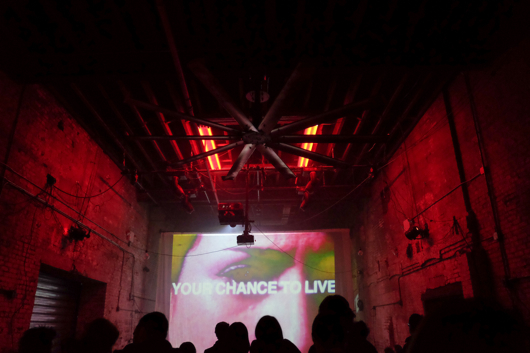
The Pre-Party at Output was the perfect intro to the weekend.
Thankfully, BEMF got off to an excellent start on Thursday night with a stacked line-up at Output. We arrived just as Mike Servito was warming up an excitable crowd in the smaller Panther Room. As a resident DJ for The Bunker, Servito has built up a solid reputation for his fierce, genre-blurring sets, and on this particular night he delivered a seamless mix of acid house, disco, and functional techno, which spoke to both his status as a seasoned record collector and stylistically inclusive DJ. Later in the night, when he’d finished his set, we overheard a group of young partiers in the crowd bemoan the fact that they’d “missed Mike.” As a Brooklyn favorite, he could not be more deserving.
Meanwhile, in Output’s main room, both the modular synth trio FORMA and Reagenz (a.k.a. the collaborative project of Move D and Spacetime Continuum) had amassed an ungodly amount of gear on the rear soundstage. Earlier in the night, The Bunker had posted photos of the equipment—analog synths, modular boxes, effects rigs, mixers, and more—sprawled out on a gigantic table, which seemed to be the most extensive live set-up for an Output party ever. It paid off. FORMA’s set skirted the line between arpeggiated synth jams and analog techno, luring the crowd into a sedated state between dancing and daydreaming. At the start of the group’s performance, we walked upstairs and were treated to a bird’s-eye view that would make anyone with a gear fetish jealous.
Much has been made of Output’s superb soundsystem, but few could have been prepared for how punchy and clear it would be with a hardware set-up. Simply put, FORMA sounded spectacular. Reagenz followed with some swirling, kosmische house that had the densely packed crowd worked up. At times, however, the pair’s live improvisations felt a touch aimless, so we eventually decided to spend the rest of our night back in the Panther Room with Pangaea. The Hessle Audio co-founder offered up an abrasive, shuffling techno set that polarized the thinning crowd, but those who stayed went insane for McAuley’s heavy acid squelches and hard-edged rhythms.
Alessandro Cortini
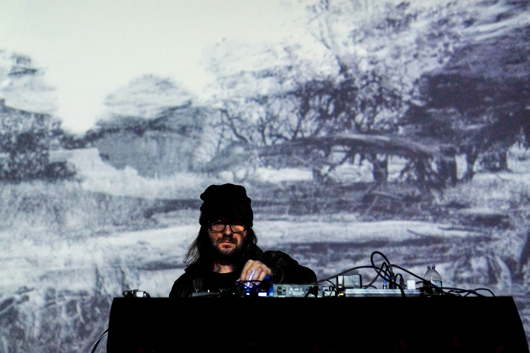
Deru’s visuals
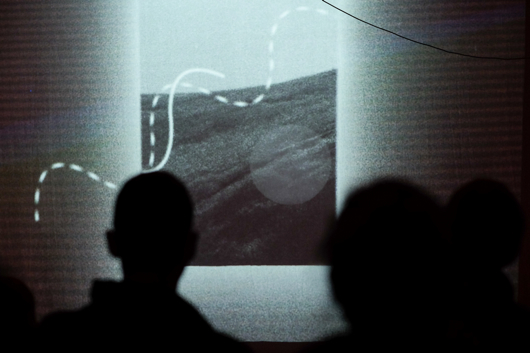
Deru’s 1979 show was cinematic and moving.
Early on Friday evening, we returned to Williamsburg just as Deru was starting his 1979 live show at Villain. The project combines a suite of drone compositions with a handmade video projector called “The Obverse Box.” Inspired by a box of letters and ephemera that Wynn found at a flea market (a time capsule of philosopher Jackson Sonnanfeld-Arden’s obsession with the nine celestial tones said to have fallen out of harmony at The Big Bang), the overall performance was gorgeous. Deru and visual artist Effixx played behind an opaque screen, on which their Obverse Box projected images of shadowed crowds, eyes, and pulsing geometric shapes. Right behind the performers, separate visuals played on a small circular surface, which added an extra depth to the proceedings. For its part, Deru’s music combined modern piano lines with nostalgic ambience, at times evoking Boards of Canada’s quieter side. The sparse crowd stood watching the performance unfold like they were at an art gallery exhibition, and Villain’s exposed brick hall was the ideal setting for just that. Later, Alessandro Cortini’s eerie synth modulations had a harder time keeping the audience engaged; Deru was a tough act to follow.
DJ Shadow and Cut Chemist gave a hip-hop lecture like tenured professors.
Leaving Villain, we were curious to see DJ Shadow’s and Cut Chemist’s Renegades of Rhythm show at Verboten, but didn’t know exactly what to expect from a night dedicated to the legacy of the “Master of Records,” Afrika Bambaataa. Upon our arrival, the club’s main room was completely packed with bros and hip-hop heads—most people didn’t have a decent view of the stage or space to move around at all, which certainly put a damper on the vibe. Pulling records from Afrika Bambaataa’s extensive personal collection, the veteran DJs wove a musical history lesson that felt more suited to a documentary than a hip-hop night. At times, the two would get on the mic and explain a track’s significance as it dropped. The crowd went wild as Shadow mixed into Yes’s 1983 megahit “Owner of a Lonely Heart,” for example, which he said was the first use of breakbeat sampling. Projected in a horseshoe around the stage, Ben Stokes’ visuals upped the edutainment with 3-D subway lines linking iconic records together in a web timeline, along with images of classic MCs and breakdancing moves. While interesting in concept, Renegades of Rhythm suffered from poor context, and the show would likely have worked much better in an intimate theater or as a film. In other words, Verboten’s club layout and the rowdy audience didn’t do Renegades of Rhythm any favors.
DJ Shadow and Cut Chemist
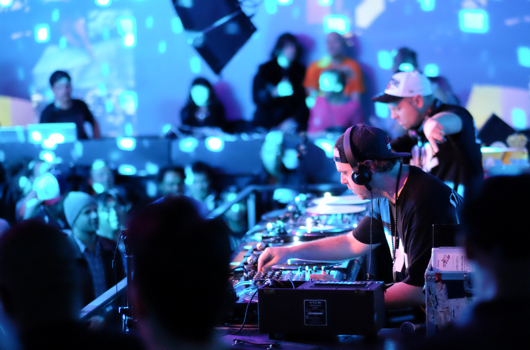
The Black Madonna
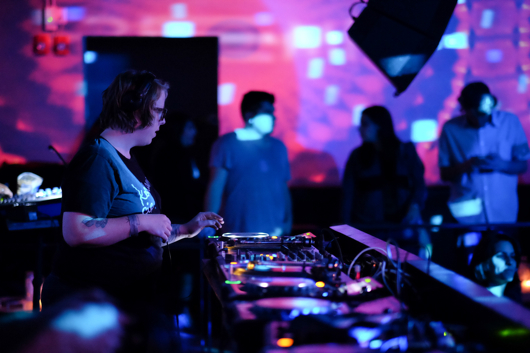
The Black Madonna was definitely a highlight.
When DJ Shadow and Cut Chemist ended their set, the room emptied in minutes, leaving a few diehards who came to see the night’s headier offerings alone on the floor. After a lengthy teardown of the entire stage, The Black Madonna tried to build back momentum with some disco-flavored house. Even as the club’s staff were still adjusting lights and shuffling around equipment, Stamper’s down-to-earth selections showed a love for the funkiest, groove-laden sounds, and the crowd was extremely receptive, using the full floor space to glide around and get weird. By focusing on deep-grooving cuts with soulful vocal samples, sexy guitar lines, and innocent melodies, Stamper kept the mood fun without pandering; we were completely won over when she dropped a kick-heavy edit of Yellow Magic Orchestra’s “Firecracker,” and it appeared the rest of audience felt the same way.
Boiler Room at Cameo Gallery provided a welcome change of vibe.
After an unfortunate run-in with EDM laser cats at Galantis’ Music Hall of Williamsburg show on Friday night, we did our best to right the ship by checking out the Boiler Room at Cameo Gallery. Starting with Love & Logic (a.k.a. New York SOUP party promoters Chris Love and AB Logic, producer AJ Halpern, and vocalist Born I Music) it was clear that this was a local party, through and through. During the course of its set, the crew delivered a range of 2-step, ghetto house, and hip-hop workouts, which the visibly sweaty crowd ate up. (A few middle-aged clubbers were even sprinkled throughout the floor and could be seen dancing with reckless abandon.) A night focused on vintage sounds, the party kept its energy level high with DJ Keoki‘s throwback selections. The former NYC “Club Kids” affiliate and Danceteria DJ dropped some reliable acid house and ’90s classics throughout his set, which the Cameo soundsystem delivered with plenty of punch. The music on offer wasn’t risky, but the all-ages crowd in the steamy venue was having an incredible time dancing to these East Coast stalwarts’ work behind the decks.
The crowd at Villain
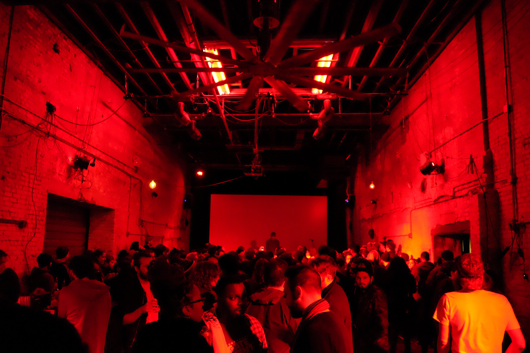
Lee Bannon
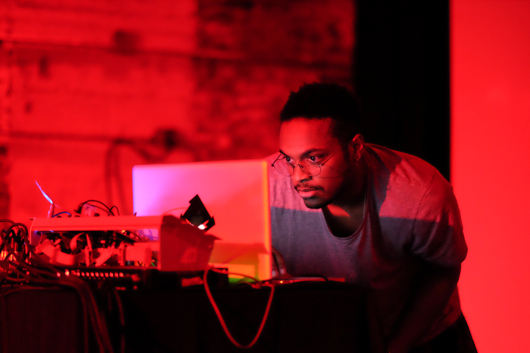
Ninja Tune knows how to put on a showcase.
On Saturday night, we headed back to Villain for one of our most anticipated events of BEMF: the Ninja Tune Stage. It didn’t disappoint. Brooklyn transplant Lee Bannon opened with a swell of sinister synth arpeggios that led into some heavy machine music, and he did a respectable job of weaving jungle and abrasive techno together with tinges of grime throughout. At one point, a snippet of SOPHIE’s “Lemonade” faded into a dance-friendly Objekt cut, which pleased the crowd. Later in the night, Machinedrum continued the breakneck pace with a relentless sequence of jungle and footwork. Furthermore, he seemed to keep at least one foot in the party-rap mindset, dropping spastic reworks of “Bound 2” and “Big Poppa,” and his on-stage enthusiasm helped to carry the crowd. After so many heavy cuts in a row, though, his set started to lose steam and could have likely benefited from better pacing.
In truth, the real highlight of the showcase was Dorian Concept. Fresh off his excellent Joined Ends LP, the Austrian wizard warmed things up with the cinematically building “Tried (Now Tired).” From there, he slowly got the crowd going with his distinct blend of G-funk and smoothed-over hip-hop, all composed with a subtle Asian influence. Soon, he was riffing like a jazz pro on the MiniKorg, which he tapped with one hand while gliding up and down the keys with the other. By the end of his set, he had built so much momentum that the crowd was hollering as he soloed up there by himself. It was a pure pleasure to listen to and watch Dorian Concept perform, and his humble stage presence made us all want to cheer him on.
Dorian Concept
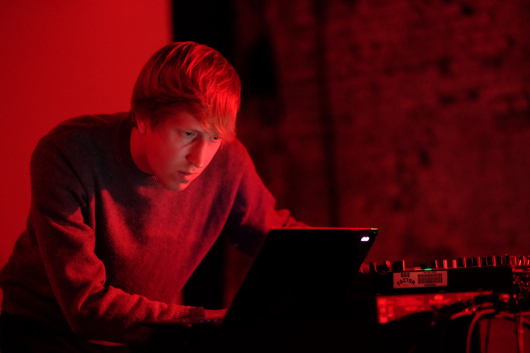
Machinedrum
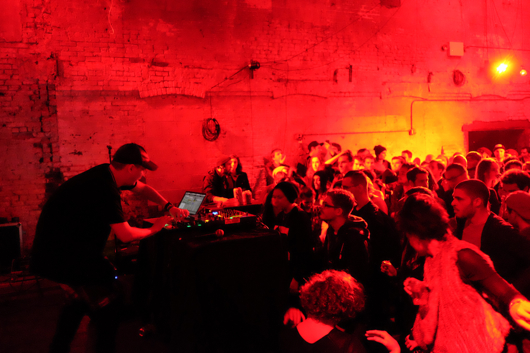
Prefuse 73 still warps hip-hop like a mad scientist.
Following the Ninja Tune showcase, we headed down to Broadway to catch Prefuse 73‘s set at Baby’s All Right. This, however, illustrated another problematic facet of the BEMF experience: long distances between certain shows. It wasn’t as cold as Friday night, but the streets were desolate as we walked under the Williamsburg Bridge and found our way to the venue. When we arrived, rapper Quelle Chris was finishing up a bizarrely comical set with Prefuse triggering beats behind him. Like an MC version of Louis C.K., the self-deprecating and goofy artist struck gladiator poses while rapping about body image. It was an entertaining warm-up for Herren’s stranger fare. After a triumphant intro from Prefuse that seemed to cut out for a few minutes due to technical issues, the producer returned to the stage, and what followed was a psychedelic hip-hop assault. Brimming with intricate sound design, the soundsystem presented Prefuse’s glitch-hop and jungle cuts in remarkable clarity. His music begs to be heard on a quality system like this, and though he hasn’t been prolific with his solo material in recent years, the show was a revelation of sorts.
Prefuse 73
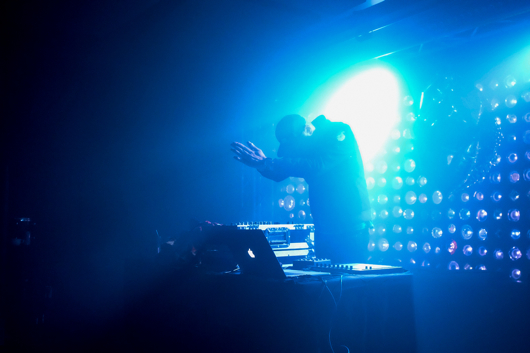
Winding down BEMF’s final night, we elected to head towards the East River and see what was happening at Glasslands. Fort Romeau had just taken the stage, and was doing his best to work the crowd in spite of the venue’s weak sound and mixer issues. During his set, he offered up a tasteful selection of cosmic disco and deep house workouts, which provided a much-needed breather from the weekend’s more intense acts. Far from the subway, with maybe two dozen people left in the venue, we couldn’t help feeling like this was the ending to a great weekend, but not a great festival. In future years, BEMF would be well served to remember that Brooklyn is a place that’s already saturated with quality electronic nights; simply cobbling together a bunch of largely unrelated shows isn’t going to make much of a lasting impression. If BEMF’s organizers really want to put on a festival that’s both interesting and successful, they should strive for something that fosters a stronger sense of community.

